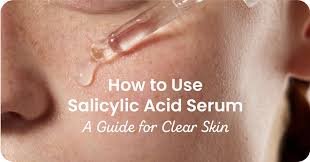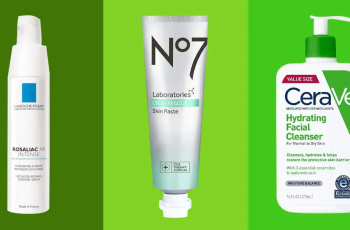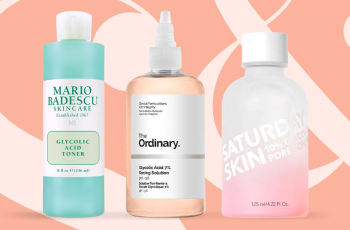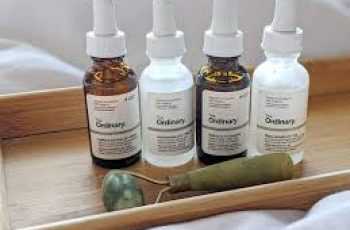
.webp)
.webp)
.webp)
Can You Use Salicylic Acid Every Day? A Clear Guide for Healthier Skin
.webp)
.webp)
Salicylic acid is a powerful beta hydroxy acid (BHA) commonly used in skincare to combat breakouts, blackheads, and oily skin. But how often can you use it safely?
.webp)
.webp)
.webp)
Is it okay to use salicylic acid every day, or does that risk overdoing it?
.webp)
.webp)
Today, we’re exploring how salicylic acid works, how often it should be used, and the best practices for incorporating it into your skincare routine without compromising your skin’s barrier.
.webp)
.webp)
.webp)
Let’s dive into the details.
.webp)
.webp)
What is Salicylic Acid and How Does It Work?
.webp)
.webp)
.webp)
Salicylic acid is a BHA derived from willow bark. Unlike alpha hydroxy acids (AHAs), salicylic acid is oil-soluble. This allows it to go deeper into the pores.
.webp)
.webp)
It exfoliates by dissolving the bonds between dead skin cells, helping shed them more effectively. It also clears out trapped oil and debris inside your pores.
.webp)
.webp)
.webp)
By doing this, salicylic acid helps prevent and treat blackheads, whiteheads, and inflamed pimples. It also minimizes congestion and promotes clearer, smoother skin over time.
.webp)
.webp)
Why Is Salicylic Acid So Popular in Skincare?
.webp)
.webp)
.webp)
Salicylic acid’s popularity comes from its multi-functional ability to exfoliate, treat acne, and improve texture. It can also calm redness and inflammation.
.webp)
.webp)
It’s often found in cleansers, serums, spot treatments, pads, and toners. Serums and spot treatments usually contain the highest concentration and offer the most direct benefits.
.webp)
.webp)
.webp)
However, its potency can lead to dryness, flaking, or irritation if used incorrectly or too often.
.webp)
.webp)
That’s why understanding how to introduce it into your routine is key.
.webp)
.webp)
.webp)
Can You Use Salicylic Acid Every Day?
.webp)
.webp)
Yes, you can use salicylic acid daily—but only if your skin tolerates it well.
.webp)
.webp)
.webp)
Dermatologists usually recommend starting slow. Use it 2–3 times a week initially to allow your skin time to adjust.
.webp)
.webp)
If you don’t notice any irritation, you can increase usage gradually. Most people with oily or acne-prone skin can build up to daily use.
.webp)
.webp)
.webp)
Those with sensitive or dry skin may only tolerate salicylic acid a few times per week.
.webp)
.webp)
What Strength of Salicylic Acid Is Safe for Daily Use?
.webp)
.webp)
.webp)
Over-the-counter salicylic acid products usually contain between 0.5% and 2%. These levels are considered safe for most skin types.
.webp)
.webp)
Anything above 2% is generally prescription-strength and should only be used under the guidance of a dermatologist or skincare professional.
.webp)
.webp)
.webp)
Here’s a quick guide on common formulations and usage:
.webp)
.webp)
Product Type % of Salicylic Acid Usage
.webp)
.webp)
.webp)
Cleanser/Gel 0.5%–2% 1x daily, rinse-off
.webp)
.webp)
Leave-on Toner/Lotion 1%–2% 1x daily or every other day
.webp)
.webp)
.webp)
Serum 1%–2% 3–4 times per week
.webp)
.webp)
Spot Treatments 2%–6% As needed, directly on blemish
.webp)
.webp)
.webp)
Exfoliating Pads 0.5%–2% 1–2x daily depending on skin
.webp)
.webp)
Start with lower concentrations and build up frequency as your skin adapts.
How Often Should You Use Salicylic Acid?
Frequency depends on your skin type, the product format, and your personal tolerance.
For Oily and Acne-Prone Skin:
Start 3x per week and increase to daily use if no irritation occurs.
Use a cleanser in the morning and a serum or toner at night.
Monitor for signs of dryness or over-exfoliation.
For Normal to Combination Skin:
Use 2–3x per week.
Opt for lower concentrations, especially in serums or pads.
Consider alternating with hydrating or calming products.
For Dry or Sensitive Skin:
Limit use to 1–2x per week.
Choose rinse-off products like cleansers to reduce exposure time.
Always follow with hydrating serums or moisturizers.
Tips for Using Salicylic Acid in Your Routine
Here are some practical tips for safe and effective use:
Always Patch Test First: Apply a small amount behind your ear or on your jawline. Wait 24 hours to check for irritation.
Avoid Overlapping Actives: Don’t use it with strong acids or retinoids in the same routine unless professionally advised.
Hydrate Generously: Use a serum or moisturizer with hyaluronic acid, glycerin, or ceramides.
Use SPF Daily: Salicylic acid can increase your skin’s sun sensitivity. Always wear SPF 30 or higher.
Apply at Night (When Possible): Skin repairs itself overnight, making this the ideal time for potent actives.
What Are the Side Effects of Salicylic Acid?
While beneficial, salicylic acid can trigger side effects—especially if overused or if your skin barrier is compromised.
Common Side Effects Include:
Tingling or mild burning on application
Dryness and tightness
Flaky or peeling skin
Redness or increased sensitivity
More Serious Reactions:
Swelling or blistering
Rash or persistent inflammation
Worsening breakouts
If you notice any severe reactions, discontinue use and consult a dermatologist immediately.
When Should You Stop Using Salicylic Acid?
Stop using salicylic acid if:
You experience extreme dryness or irritation.
Your skin becomes red, inflamed, or itchy.
You develop swelling or blisters.
Your breakouts worsen after 4–6 weeks of consistent use.
In some cases, breakouts may initially worsen—a process called “purging.” This can last 2–4 weeks but should gradually improve.
If it continues or worsens, stop using the product and seek professional advice.
What Ingredients Pair Well with Salicylic Acid?
Combining salicylic acid with hydrating and barrier-repairing ingredients can enhance results and protect your skin.
Best Ingredients to Pair With Salicylic Acid:
Hyaluronic Acid – for deep hydration and skin balance.
Niacinamide – helps calm inflammation and strengthen the barrier.
Zinc – regulates oil production and reduces acne.
Centella Asiatica – calms redness and soothes irritation.
Ceramides – rebuild and protect the skin barrier.
These ingredients help offset potential dryness or irritation caused by exfoliation.
What Ingredients Should You Avoid With Salicylic Acid?
Avoid combining salicylic acid with other strong actives in the same routine unless instructed by a skincare expert.
Use Caution With:
Retinol – too drying when combined in one routine.
Glycolic/Lactic Acid (AHAs) – can lead to over-exfoliation.
Vitamin C – may cause irritation or reduce effectiveness.
Benzoyl Peroxide – overly harsh together and can damage the skin barrier.
Instead, alternate these ingredients in your routine. For example, use retinol at night and salicylic acid in the morning.
Is It Normal to Break Out After Starting Salicylic Acid?
Yes, temporary breakouts can occur. This is called purging and typically happens as the acid pushes impurities to the surface.
It usually lasts 2 to 4 weeks and is a sign that the product is working. You’ll likely see blackheads, whiteheads, and small pimples.
However, if your skin doesn’t improve after 6 weeks or worsens, it may not be purging. That could be irritation or a reaction.
If that’s the case, reduce use or stop entirely and speak with a dermatologist.
Final Thoughts: Can You Use Salicylic Acid Daily?
Yes, salicylic acid can be used daily by most people—but it’s crucial to start slowly and build up usage.
Every skin type reacts differently. Monitor your skin and adjust your frequency accordingly. For oily or acne-prone skin, daily use may be ideal. For sensitive skin, less is more.
Pair salicylic acid with calming and hydrating ingredients, and always use sunscreen to protect your skin barrier.
When used properly, salicylic acid can become your skin’s best friend—helping you achieve a clearer, more radiant complexion with consistent use.
Want more skincare advice? Follow us on Instagram @Procoal for daily tips, ingredient spotlights, and product recommendations tailored to your skin type.



